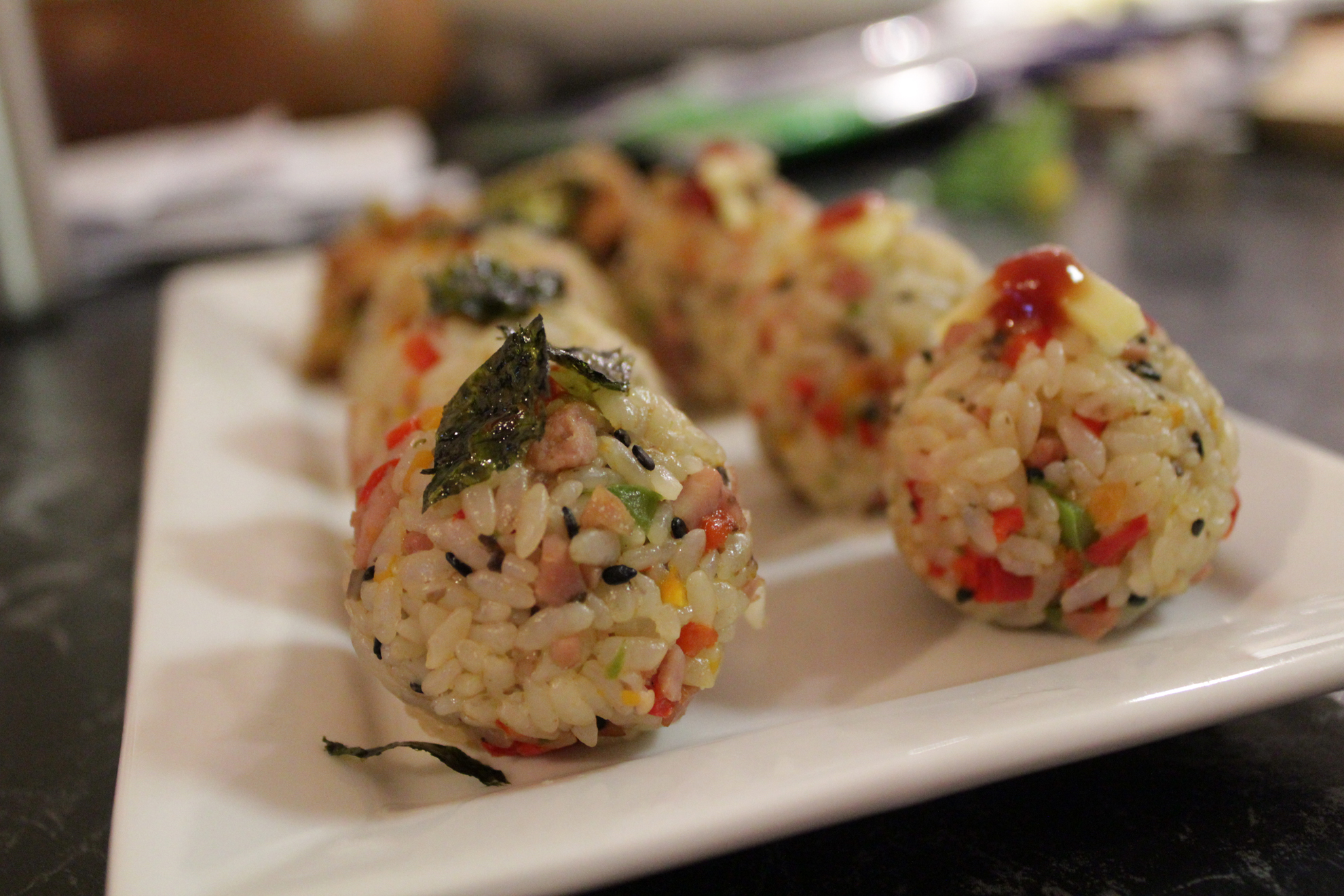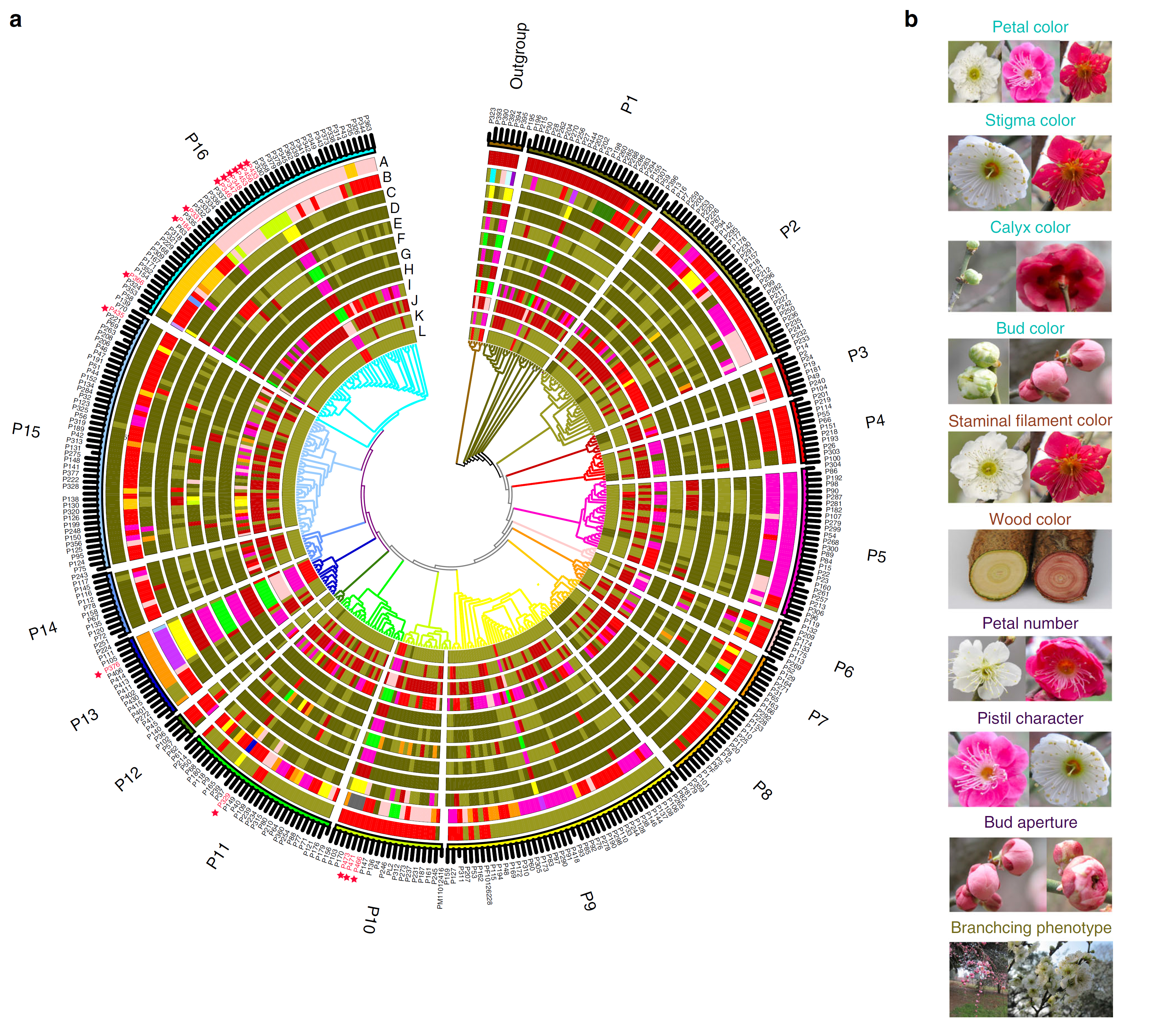|
Onigiri
, also known as or , is a Japanese cuisine, Japanese rice ball made from white rice. It is usually formed into triangular or cylindrical shapes, and wrapped in ''nori'' (seaweed). Onigiri traditionally have sour or salty fillings such as ''umeboshi'' (pickled Prunus mume, Chinese plum), salted salmon as food, salmon, ''katsuobushi'' (smoked and fermented bonito), kombu, ''tarako'' or ''mentaiko'' (pollock roe), or ''takanazuke'' (pickled brassica juncea, Japanese giant red mustard greens). Because it is easily portable and eaten by hand, onigiri has been used as portable food or bento from ancient times to the present day. Originally, it was used as a way to use and store left-over rice, but it later became a regular meal. Many Japanese convenience stores and supermarkets stock onigiri with various fillings and flavors. It has become so mainstream that it is even served in izakayas and sit-down restaurants. There are even specialized shops which only sell onigiri to Take-out, t ... [...More Info...] [...Related Items...] OR: [Wikipedia] [Google] [Baidu] |
γζ‘γ
, also known as or , is a Japanese rice ball made from white rice. It is usually formed into triangular or cylindrical shapes, and wrapped in ''nori'' (seaweed). Onigiri traditionally have sour or salty fillings such as ''umeboshi'' (pickled Chinese plum), salted salmon, ''katsuobushi'' (smoked and fermented bonito), kombu, ''tarako'' or ''mentaiko'' ( pollock roe), or ''takanazuke'' (pickled Japanese giant red mustard greens). Because it is easily portable and eaten by hand, onigiri has been used as portable food or bento from ancient times to the present day. Originally, it was used as a way to use and store left-over rice, but it later became a regular meal. Many Japanese convenience stores and supermarkets stock onigiri with various fillings and flavors. It has become so mainstream that it is even served in izakayas and sit-down restaurants. There are even specialized shops which only sell onigiri to take out. Due to the popularity of this trend in Japan, onigiri has be ... [...More Info...] [...Related Items...] OR: [Wikipedia] [Google] [Baidu] |
Rice Ball
A rice ball may be any kind of food item made from rice that has been shaped, condensed, or otherwise combined into a ball shape. Rice balls exist in many different cultures in which rice is eaten, and are particularly prevalent in Asia. Rice balls are a convenient and portable food that can be eaten on the go, making them a popular choice for picnics, road trips, and packed lunches. They are also often enjoyed as a snack or side dish with meals. The rice may be seasoned with a variety of ingredients, such as salt, furikake, or other seasonings, and may also be topped or filled with a variety of foods, such as fish, meat, or vegetables. Types of rice balls Types of rice ball include: *Arancini, an Italian cuisine, Italian Frying, fried rice ball coated with breadcrumbs. *Jumeok-bap, a Korean cuisine, Korean rice ball from cooked rice formed into oval shapes. *Omo tuo, a Ghanaian cuisine, Ghanaian staple food that is more smooth and soft due to its higher volume of water, us ... [...More Info...] [...Related Items...] OR: [Wikipedia] [Google] [Baidu] |
Norimaki
''Norimaki'' (ζ΅·θε·») are various Japanese dishes wrapped with nori seaweed, most commonly a kind of sushi, ''makizushi'' (ε·»γε―ΏεΈ). Other than ''makizushi'', ''onigiri'' (γγ«γγ, rice balls), ''sashimi'', ''senbei'' (η ι€ , rice crackers), and ''chikuwa'' (η«ΉθΌͺ, bamboo ring) are also regarded as ''norimaki'' if they are wrapped with seaweed. Description ''Makizushi'' ''Makizushi'' (, "rolled sushi") was first described in the 1750 publication "Ryori SanKaigo" as makizushi (). In the 1787 publication "Shichigokobi", it was mentioned as being on the menus of sushi restaurants in Edo as sushi that does not stain the hands. In the early days of ''makizushi'', there were many other types of sushi rolled in other than seaweed, such as those rolled in thinly roasted eggs, or those rolled in shallow seaweed, wakame seaweed, or bamboo bark and so on. In Tokyo, there exists ''kampyo-maki'' (εΉ²η’ε·», dried gourd rolls) made in the Edo period. The combination of ''i ... [...More Info...] [...Related Items...] OR: [Wikipedia] [Google] [Baidu] |
Bento
A is a Japanese-style single-portion take-out or home-packed meal, often for lunch, typically including rice and packaged in a box with a lid (often a segmented box with different parts of the meal placed in different sections). Outside Japan, similar meals are common in other East and Southeast Asian culinary styles, especially within Chinese, Korean, Singaporean, Taiwanese cuisines and more, as rice is a common staple food in the region. The term ''bento'' is derived from the Chinese term ''biandang'' (, ), which means "convenient" or "convenience". A traditional ''bento'' typically includes rice or noodles with fish or some other meat, often with pickled and cooked vegetables in a box."Bento: Changing New York's Lunch Culture," ''Chopsticks NY,'' vol. 27, July 2009, p. 10-11. Containers range from mass-produced disposable containers to hand-crafted lacquerware. Dividers are often used to separate ingredients or dishes, especially those with strong flavors, to avoi ... [...More Info...] [...Related Items...] OR: [Wikipedia] [Google] [Baidu] |
Nigirizushi
is a traditional Japanese dish made with , typically seasoned with sugar and salt, and combined with a variety of , such as seafood, vegetables, or meat: raw seafood is the most common, although some may be cooked. While sushi comes in numerous styles and presentation, the current defining component is the vinegared rice, also known as , or . The modern form of sushi is believed to have been created by Hanaya Yohei, who invented nigiri-zushi, the most commonly recognized type today, in which seafood is placed on hand-pressed vinegared rice. This innovation occurred around 1824 in the Edo period (1603β1867). It was the fast food of the ''chΕnin'' class in the Edo period. Sushi is traditionally made with medium-grain white rice, although it can also be prepared with brown rice or short-grain rice. It is commonly prepared with seafood, such as squid, eel, yellowtail, salmon, tuna or imitation crab meat. Certain types of sushi are vegetarian. It is often served with , w ... [...More Info...] [...Related Items...] OR: [Wikipedia] [Google] [Baidu] |
Prunus Mume
''Prunus mume'', the Chinese plum or Japanese apricot, is a tree species in the family Rosaceae. Along with bamboo, the plant is intimately associated with art, literature, and everyday life in China, from where it was then introduced to Korea, Vietnam, and Japan. ''Prunus mume'' is also referred to by its flowers, as a plum blossom or flowering plum. Although referred to as a ''plum'' in English, is classified in the ''Armeniaca'' section of the genus ''Prunus'' making it an apricot. ''Mei'' flowers, or ''meihua'' (), which bloom in the late winter and early spring, notably during the spring festival (ζ₯η―), symbolize endurance, as they are the first to bloom despite the cold; the flower is one of the Three Friends of Winter. In East Asian cuisine ( Chinese, Japanese, Korean, and Vietnamese cuisine), the fruit, known as ''meizi'' ( ζ’ ε) in Chinese, is used in juices and sauces; as a flavoring for alcohol; and may be pickled or dried. It is also used in tradition ... [...More Info...] [...Related Items...] OR: [Wikipedia] [Google] [Baidu] |
Cifantuan
''Cifantuan'', also known simply as ''chi faan'' or ''fantuan'', is a glutinous rice dish in Chinese cuisine originating in the Jiangnan area of eastern China which encompasses Shanghai and surrounding regions. It is made by tightly wrapping a piece of ''youtiao'' (fried dough) with glutinous rice. It is usually eaten as breakfast together with sweetened or savory soy milk in its native Jiangnan. Today, ''cifantuan'' is commonly available in two varieties. Whereas the " savory" variety includes ingredients such as '' zha cai'' (pickled vegetable), '' rousong'' (pork floss) and small pieces of ''youtiao'' being wrapped in the rice ball, the "sweet" variety adds sugar and sometimes sesame to the filling. There are many modern variations of the food which are made from purple rice and include fillings such as tuna, kimchi, or cheese. ''Cifantuan'' is a major breakfast food item in Shanghai. ''Cifantuan'' is also popular in Hubei, Taiwan and Hong Kong. See also * List of rice di ... [...More Info...] [...Related Items...] OR: [Wikipedia] [Google] [Baidu] |
Takuan
''Takuan'' (; also spelled ''takuwan''), or ''takuan-zuke'' (; 'pickled takuan'), known as ''danmuji'' () in the context of Korean cuisine, is a pickled preparation of daikon radish. As a popular part of traditional Japanese cuisine Japanese cuisine encompasses the regional and traditional foods of Japan, which have developed through centuries of political, economic, and social changes. The traditional cuisine of Japan (Japanese language, Japanese: ) is based on rice with m ..., ''takuan'' is often served uncooked alongside other types of ''tsukemono'' ('pickled things'). It is also enjoyed at the end of meals to aid digestion. History In Japan, famous Buddhist monk Takuan SΕhΕ (1573β1645) is popularly credited with creating this yellow pickle, which now bears his name.Nagamura, Kit"All at sea in Shinagawa" ''The Japan Times Online''. October 5, 2007. Accessed July 11, 2011. Usage Usually, ''takuan'' is washed with water to remove excess Brining, brine and then s ... [...More Info...] [...Related Items...] OR: [Wikipedia] [Google] [Baidu] |
Zongzi
''Zongzi'' () or simply ''zong'' () is a traditional Chinese rice dish made of glutinous rice stuffed with a range of fillings and wrapped in bamboo leaves. Fillings can be either sweet, such as red bean paste, or savory, such as pork belly or Chinese sausage. The bamboo for wrapping the ''zongzi'' is generally of the species ''Indocalamus tessellatus'', although sometimes common reed, reed or other large flat leaves may be used. ''Zongzi'' are cooked by steaming or boiling. Names As it diffused to other regions of Asia over many centuries, ''zongzi'' became known by various names in different languages and cultures, including ''phet htoke'' () in Burmese language, Burmese-speaking areas (such as Myanmar), ''nom chang'' in Cambodia, ''machang'' in Philippines, ''bacang'' in Indonesia, ''khanom chang'' in Laos, and ''ba-chang'' in Thailand. Vietnamese cuisine also has a variation on this dish known as ''bΓ‘nh ΓΊ tro'' or ''bΓ‘nh tro''. In Malaysia, Indonesia, Singapore, and ... [...More Info...] [...Related Items...] OR: [Wikipedia] [Google] [Baidu] |








